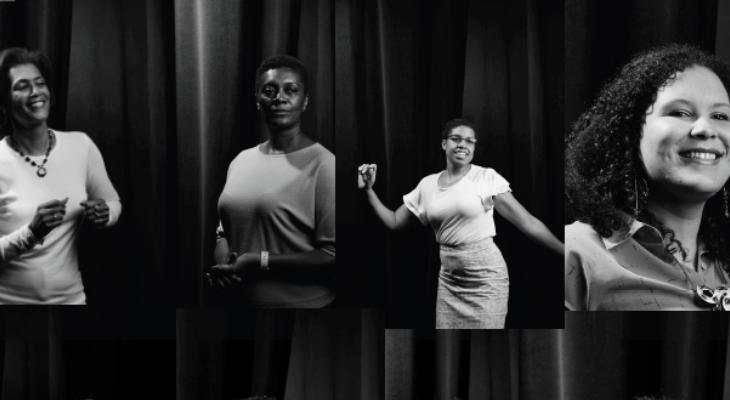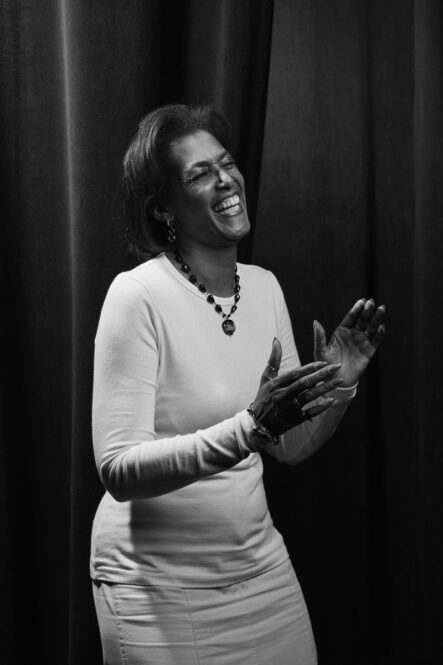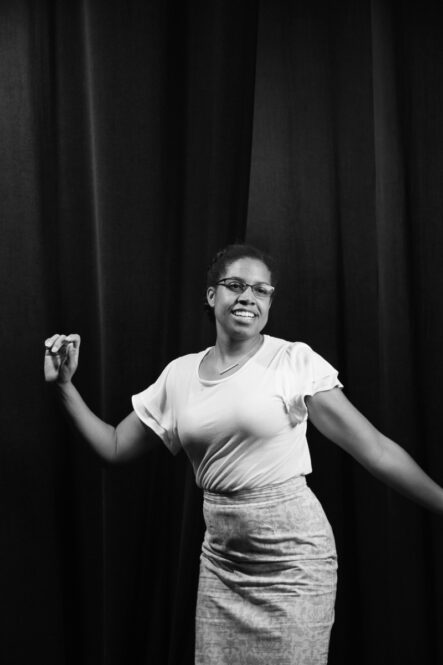The Movement of Joy: Archiving Black Joy and Spirituality Through Dance
March 24, 2022

Naila Ansari grew up in Buffalo, New York, surrounded by the support of Black women from interfaith communities. Her father was an Imam for a Muslim community, her mother converted to Islam from Christianity, and she went to a school with a big Jewish population. The women in her life helped her lead through wisdom and lessons rooted in their diverse spiritual beliefs and their stories of experiencing life as Black women of faith in America.
So, when she faced a really difficult moment in her life – navigating through divorce as a single Black mom, she turned to them for support and asked them: What brings you joy in moments of crisis?
This search for joy within herself and the women around her led her to create “Movement of Joy” — a digital project and a book that focuses on the performance of joy through the creative archiving of oral histories, social movement histories, live-performance, and film.
Share
Related Articles
In conversation with Interfaith America’s Silma Suba, Ansari — an award-winning choreographer, performing artist, and educator — shares the importance of archiving Black joy, how holding on to joy impacts a community, and the lessons she learned working on this project.
What is the “Movement of Joy”?
The movement of joy kind of filters in multiple spaces. It is an archiving of sorts…it’s the idea that Black women are becoming the teachers of joy, and the ways that we hold our legacies can then filter into other communities. It is a live performance at times. It’s also a digitized and documented version of an archive…it’s really kind of sharing these stories of women, particularly Black women, talking of joy.
As an artist, the work is kind of looking at the parallels of what’s happening movement-wise at different times politically in the US, and then what kind of Black movements have risen both physically and theoretically from Black women.
An example would be the late Marjory Smarth. She was a Black woman who really is a pioneer of house dance. And she created a space for a lot of Black folks, brown folks, white folks, queer folks, to come in and find joy through movement. It was right after the Stonewall riots. She really kind of pioneered Black folks into these safe spaces that really for a lot of people was spiritual and kind of a revelation. So, the project and the book focus on these Black women that have created these movements during difficult times and how they’ve used movement to cultivate joy.
What inspired you to create this project?
I was going through a really difficult time in grad school. I was working through a divorce, and through that, became a single Black mom. I had an advisor who was a Black queer man and he said to me, “You don’t have to focus so much on rage or anger. What else do you need to focus on right now?” And something clicked – it was joy. At that moment I decided to use my research in finding joy for myself – and because I didn’t have an answer – I turned to the elder Black women in my community to ask what brought them joy. It brought me back to my childhood surrounded by Black women from different faith communities, and there are so many different ways that spirituality and faith kind of connects Black women to the divine or the higher power.
In doing that research, I recognized that a lot of Black women could not answer that question for themselves. They answered it, but there was always a silence first. That became part of the work that I started to do as a researcher as an academic: How do we bring Black women into the space of joy? How do we uplift that joy and help them name it, without a long pause? And then, how do I write about it? How do I create a performance out of it? How do we create spaces and create performances out of what has already existed or what can exist?
For each woman that I interview, I ask them to pick their favorite song or a song that gives them joy. They dance to it, and we take photographs of them in that movement. And within the recording, I take that movement and recreate a performance, if you will. It’s almost storytelling through movement, not just through the music, not just through the text, but also through the digital component of it.

Photo by Mustafa Hussain
What do Black joy and spirituality mean to you?
To me, it means the contentment of self. Like, no one can take away your joy. So often we allow people to take away something that isn’t theirs, that isn’t God given to them, that isn’t something that connects them to the Divine. Joy really is our own connection to the present saying, “I’m here, I exist.” Even if COVID-19 is out there, I’m still able to find those tools and those resources for myself that can give me joy.
I think that Black folks have done that for a very long time. And I think that we have cultivated so much of our rage in specific ways. But that rage can also be joyous as well. Often, we don’t understand that the space of contentment doesn’t mean that I’m necessarily content with the situation, but it means that if I need to fight, I am content with fighting. I would say Black joy is really that sense of spirituality and contentment.
What do you want people to take away from this project?
We have been conditioned to see the struggle and all the other things outside of joy that Black women experience, but we have to have a community that’s willing to see our joy too. The witnessing of joy is just as important as discovering the joy for yourself. That is definitely a part of the project.
The other part of the project is for the archive to be a form of legacy. One of the women that I interviewed passed away. The last thing that she said, that was recorded, was her speaking about her joy. I gave it to her son during her funeral. That’s what makes me continue this project – it’s more than an academic thing, it’s more than me finding joy within myself, it’s about the community around me, and the impact of Black women’s joy and what it does for not only their families but to the community they are in. We won’t all be here one day, and if we are able to go back and see someone in their joyous moments, then nothing else is better than that.
How has talking about Black joy in your work impacted your life and those around you?
To have the women that I’ve worked with come back to me and say, “I think about my joy” or “I’m able to articulate boundaries for myself because I know that something brings me joy” — that’s the most profound thing that has personally affected me.
There’s a story that I use often to talk about the importance of joy in relationships: If you tell your partner that reading gives me joy, and your partner comes to you and says, “I hate that you’re reading, I don’t like when you read,” well, this is just not going to work then. Because what you’re saying is that the ultimate thing that gives me contentment in my private space doesn’t work for you. So, this [relationship] doesn’t work for me. Understanding that has helped me a lot in my personal relationships and has become a teaching tool for me.
I did a workshop recently with Black men and shared some of the stories about these Black women whose stories I’ve archived, and it’s interesting because a lot of them thought about their mothers and said, “I wish I knew what gave them joy.” Because what people don’t know is when you talk about your joy to somebody, you’re also inherently telling them about yourself. And they’re typically those things that people don’t really know about you. They may see it as like you have a hobby, but they don’t really understand how significant it is for you. The biggest takeaway that I’ve had from this project and doing the workshops is being able to cultivate all these stories and really bring it together and share them with others and say, “Hey, you’re not alone in doing the things that bring you joy.” Every single time I do these workshops, I am discovering joy, and in a way helping others discover their joys as well.

Photo by Mustafa Hussain
What brings you joy?
Writing is something that I’ve taken joy in practicing. Meditation has given me joy; randomly listening to whatever songs come to my mind while just kind of relaxing, or cleaning, has given me joy. Going back and being with friends in any kind of capacity during COVID has helped me recognize that the social part of connecting with people is something that also gives me joy. What I will say about joy is that it is ever-changing. It’s also very consistent if you’re clear about the present ever-changing things that are happening within you and recognize that every day is not the same. I may like reading, but that book I read recently was really s—-y. That book did not give me joy, but it’s the actual practice of opening the book, the reading, the going to a store to get a new book – it’s the practice of me discovering joy that gives me joy.
How do you navigate your faith and spirituality through your work and dance?
In certain ways, it feels like two spaces. I’ve learned that both for me are joyous. A lot of us are taught that [religion] looks like this, and to be a good practicing Muslim, you have to do this or that. Doing research and understanding the research about myself and where we come from, my understanding is that the talent that God gave me is also a spiritual practice that allows me to fulfill my faith. It allows me to fulfill my religion. So, I don’t think of them as separate. I think of them as a mutual agreement with each other, and I don’t know that I could live without either one of them. Because the ways in which I serve people have definitely been part of my religious base, the way that I also serve people is through the spiritual connection that I have with dance.
What’s the importance of holding onto joy, especially for the Black community, in times of crisis?
I think the most important thing is to recognize that everybody’s joy cultivates to create a more harmonious space. When you’re angry, and you don’t have joy and happiness for yourself, you can’t find it in other people, you can’t pull it out of other people, you can’t cultivate it in a space. What we have in rage and eloquent rage is absolutely important. What is also equally important is our joy. We also have to bring that into the space because we have to see humaneness in all of us.
Maybe someone finds joy in writing, that joy can be a sense of activism. Someone who finds joy in performance, that joy is a sense of activism. Someone who finds joy in activism is a sense of activism. It is through our joys that we are going to be able to continue that fight, to continue to create change, and continue to live in our space of infinite possibilities in greatness.
This article was originally posted on February 23, 2022.



